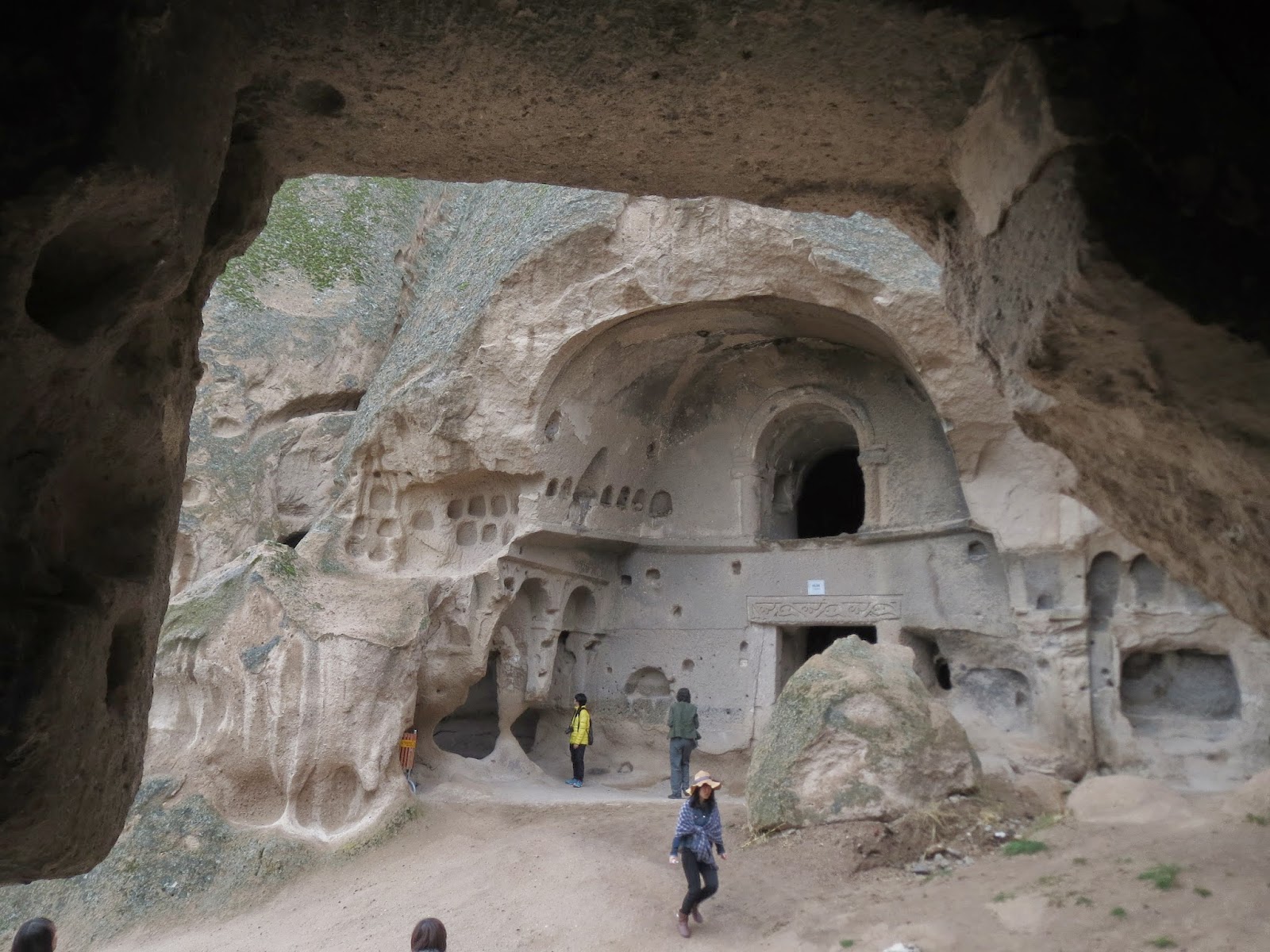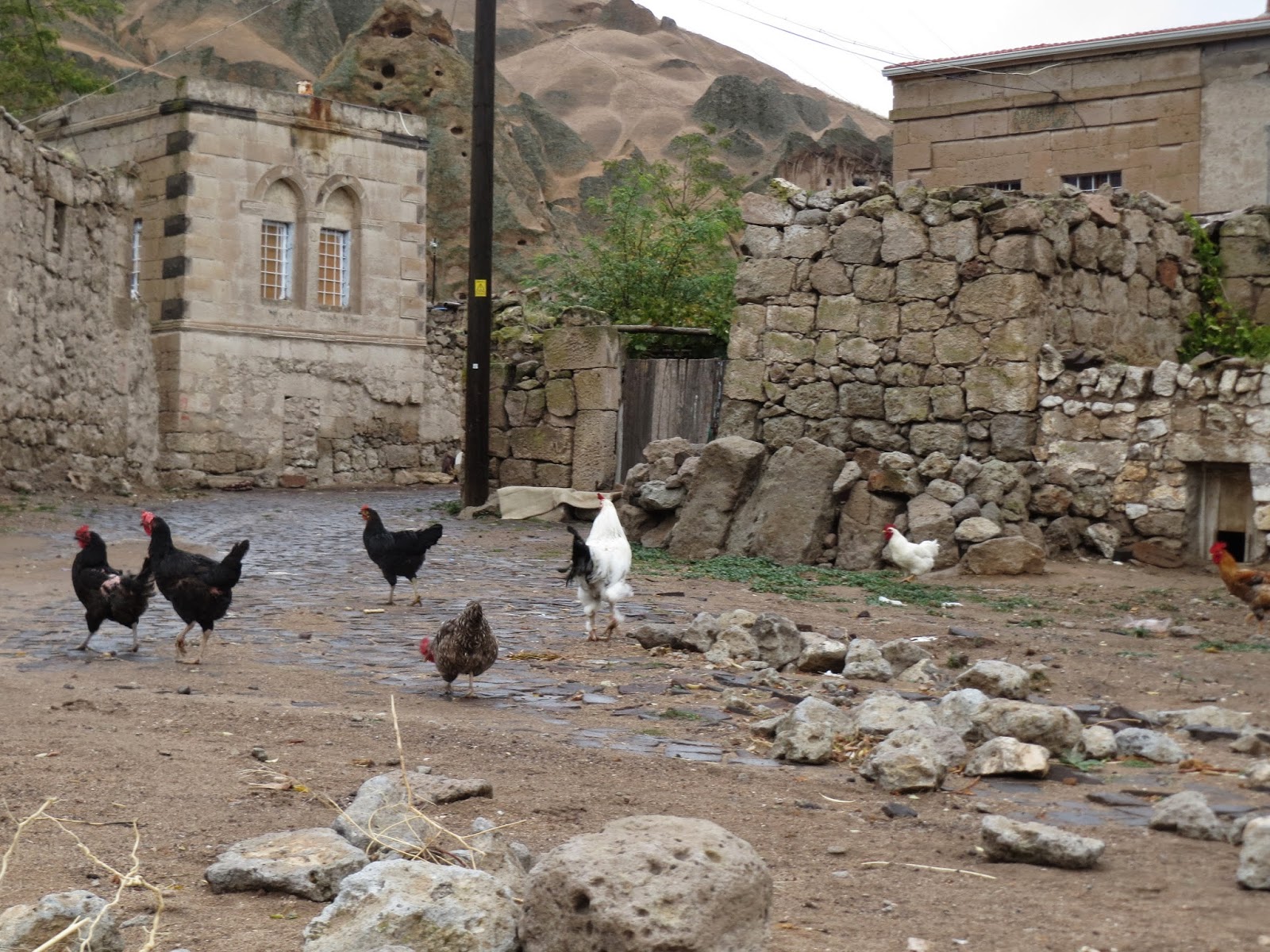We wanted to visit the Cappadocia region of Central
Turkey after hearing about
it from our daughter, Natalie, who visited Turkey Cappadocia . In Cappadocia , there are unimaginable rock formations, spectacular
valleys, ancient cave churches and underground cities that reach many stories
beneath the surface and could house thousands of people.
More than 100 million years
ago, 3 volcanoes in Cappadocia erupted, dropping lava, mud, and ash over the region.
Over eons, the explosive products cooled and compressed to form tufa, a soft,
porous rock easily worn down by erosion. Water pored down, carving and
separating giant ridges the rock into gorgeous valleys. Wind further whipped
around the formations, further shaping them into elaborate pinnacles, cones,
pillars and mounds. Harder layers of rocklike basalt resisted erosion longer
and often ended up balanced, like hats, on top of a tall cone. Oxidation gave
the formations color, and then humans began to do their own carving and
shaping.
After pulling an all nighter at
the Antalya Airport on the Mediterranean coast and not being able to check our
bags in until 2AM for our 3:40 departure to Nevsehir Airport, an hour west of the town of Goreme where we were staying in
Cappadocia, we were just the wee bit tired getting to the hotel around 9am!
Nonetheless, after dumping our bags at the Elysee Cave House, we decided to hop
onto the all day Ilhara Valley Tour leaving at 9:30 . Steven was quite happy doing it as it meant that he
could sleep while on the bus and only had to awaken when I prodded him saying
the bus was stopping at an overlook or having to get out and hike, eat lunch.
It also meant that neither of us had to make any decisions all day long!
The Goreme Panorama was our first stop and what a sight it was to behold the breathtaking views. Steven and I both remarked on the similarity to Bryce Canyon National Park in Utah but the size and sheer number of spires, cones, etc is far greater than those at Bryce.We only had about 15 minutes to take in the sights, grab a drink of cay, i.e. strong Turkish tea served in small glass cups on a saucer and/or buy any souvenirs before being herded back on the bus.
Cappadocia , our guide told us, is an Old Persian translation meaning Land of Beautiful Horses
Next up was a stop at the Derinkyu Underground City, one of 36 underground cities in the area; only 10 are now open to the public though. All the tours stop at this one though because it’s the largest and the deepest at 85m; it has 16 levels and up to 1,300 people could survive living entirely underground for up to a month at a time. It was built by the Hitites and then used by the orthodox Greeks from the 4th through the 11th centuries. It received UNESCO designation in 1964. We spent about an hour down there which was quite enough for me, thank you! It was certainly eye opening to visualize how people coped living in such confined quarters and to see the morgue, the ventilation system, the cooking area, the stables, etc.
The chicken sis or
shish kebab was one of the best meals certainly in Turkey
The rain had started in earnest while we were eating but most of the group chose to go on a 2.5 mile hike through the Ilhara Valley anyway. It was much like hiking at a number of mountain parks inColorado
The guide did lead us to one lovely old church called Agacali before we continued our walk in the Ilhara Valley.
One of the strangest sights I’ve ever seen was field upon field full of apparently harvested huge pumpkins, not surprising when 95% of the country's pumpkin industry is inCappadocia ! But the guide explained that the pumpkins are only
grown for their seeds, a snack loved by Turks. Once the seeds are extracted,
the pumpkins remain on the ground until some are used for animal food.
The tour’s final stop was at Pigeon Valley; we had seen hundreds of pigeon holes in the rocks throughout the day but only learned here that the people carved the dovecotes or holes into the rocks to attract pigeons in order to collect their droppings for fertilizing their crops, especially vineyards.
The Goreme Panorama was our first stop and what a sight it was to behold the breathtaking views. Steven and I both remarked on the similarity to Bryce Canyon National Park in Utah but the size and sheer number of spires, cones, etc is far greater than those at Bryce.We only had about 15 minutes to take in the sights, grab a drink of cay, i.e. strong Turkish tea served in small glass cups on a saucer and/or buy any souvenirs before being herded back on the bus.
Next up was a stop at the Derinkyu Underground City, one of 36 underground cities in the area; only 10 are now open to the public though. All the tours stop at this one though because it’s the largest and the deepest at 85m; it has 16 levels and up to 1,300 people could survive living entirely underground for up to a month at a time. It was built by the Hitites and then used by the orthodox Greeks from the 4th through the 11th centuries. It received UNESCO designation in 1964. We spent about an hour down there which was quite enough for me, thank you! It was certainly eye opening to visualize how people coped living in such confined quarters and to see the morgue, the ventilation system, the cooking area, the stables, etc.
 |
 |
| One of the tunnels |
 |
After seeing quite enough of
the
|
The rain had started in earnest while we were eating but most of the group chose to go on a 2.5 mile hike through the Ilhara Valley anyway. It was much like hiking at a number of mountain parks in
 |
| We hiked to the bottom of the canyon before beginning the actual hike through the valley. |
The guide did lead us to one lovely old church called Agacali before we continued our walk in the Ilhara Valley.
Next up was a visit to the Selime
Monastery where we scrambled up over rocks that we could only reach by
walking through crevices so narrow we could only put one foot in front of the
other. Was I ever glad that neither of us had wider feet as we couldn’t have
reached certain areas.
 |
One of the strangest sights I’ve ever seen was field upon field full of apparently harvested huge pumpkins, not surprising when 95% of the country's pumpkin industry is in
The tour’s final stop was at Pigeon Valley; we had seen hundreds of pigeon holes in the rocks throughout the day but only learned here that the people carved the dovecotes or holes into the rocks to attract pigeons in order to collect their droppings for fertilizing their crops, especially vineyards.










































All I can say is WOW WOW WOW. Hope to see you soon, it seems forever. Love Becky
ReplyDelete